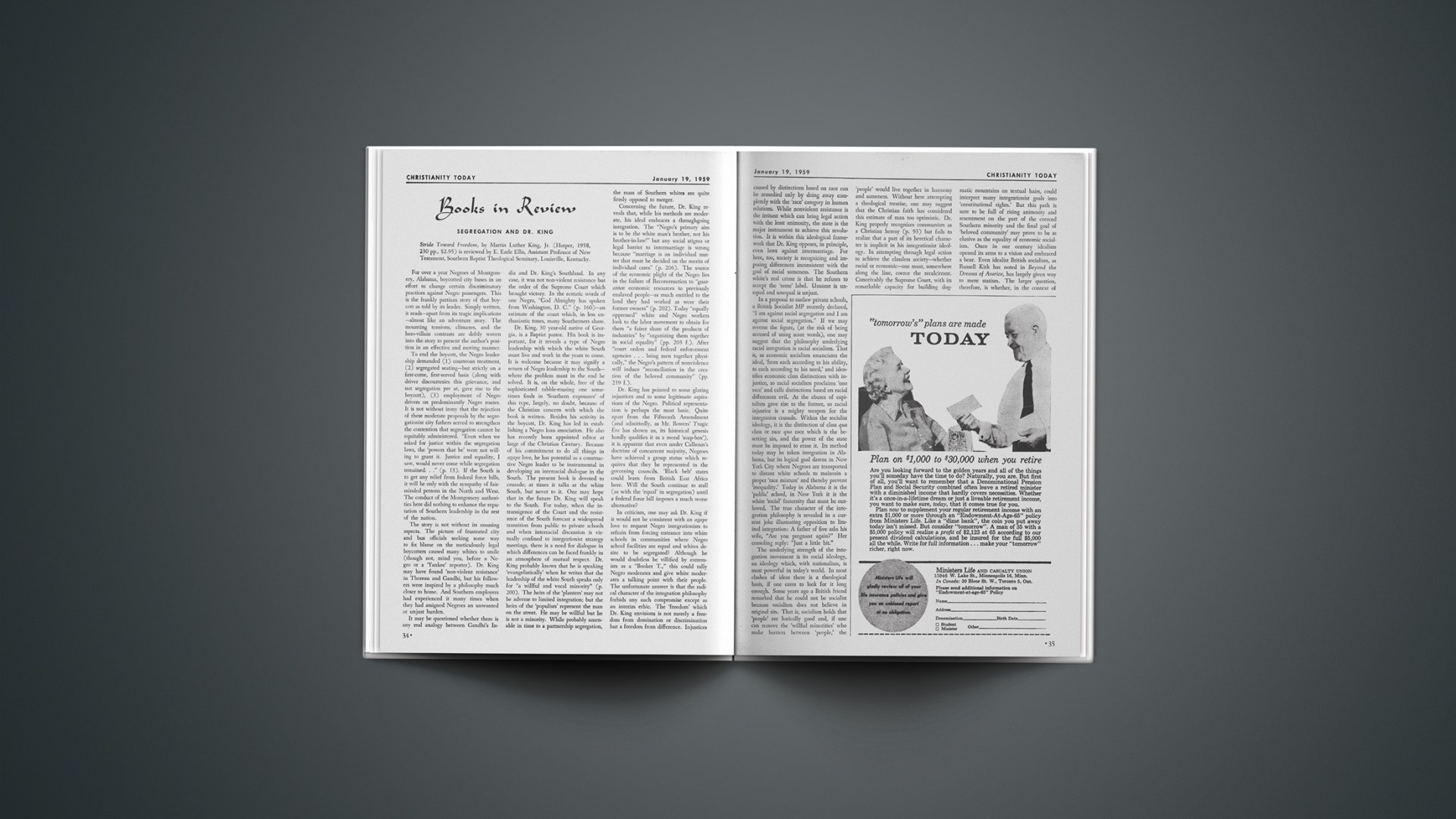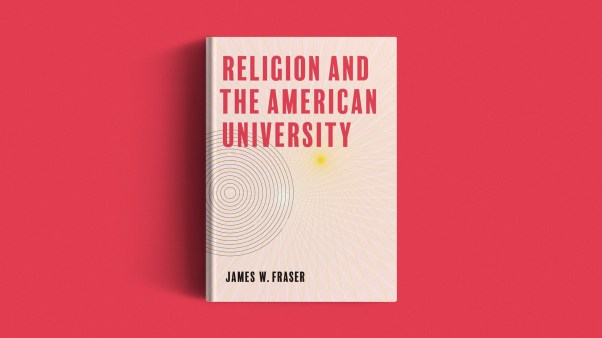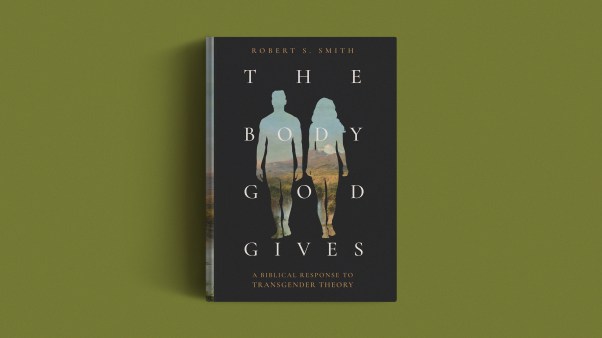Segregation And Dr. King
Stride Toward Freedom, by Martin Luther King, Jr. (Harper, 1958, 230 pp., $2.95) is reviewed by E. Earle Ellis, Assistant Professor of New Testament, Southern Baptist Theological Seminary, Louisville, Kentucky.
For over a year Negroes of Montgomery, Alabama, boycotted city buses in an effort to change certain discriminatory practices against Negro passengers. This is the frankly partisan story of that boycott as told by its leader. Simply written, it reads—apart from its tragic implications—almost like an adventure story. The mounting tensions, climaxes, and the hero-villain contrasts are deftly woven into the story to present the author’s position in an effective and moving manner.
To end the boycott, the Negro leadership demanded (1) courteous treatment, (2) segregated seating—but strictly on a first-come, first-served basis (along with driver discourtesies this grievance, and not segregation per se, gave rise to the boycott), (3) employment of Negro drivers on predominantly Negro routes. It is not without irony that the rejection of these moderate proposals by the segregationist city fathers served to strengthen the contention that segregation cannot be equitably administered. “Even when we asked for justice within the segregation laws, the ‘powers that be’ were not willing to grant it. Justice and equality, I saw, would never come while segregation remained …” (p. 13). If the South is to get any relief from federal force bills, it will be only with the sympathy of fair-minded persons in the North and West. The conduct of the Montgomery authorities here did nothing to enhance the reputation of Southern leadership in the rest of the nation.
The story is not without its amusing aspects. The picture of frustrated city and bus officials seeking some way to fix blame on the meticulously legal boycotters caused many whites to smile (though not, mind you, before a Negro or a ‘Yankee’ reporter). Dr. King may have found ‘non-violent resistance’ in Thoreau and Gandhi, but his followers were inspired by a philosophy much closer to home. And Southern employers had experienced it many times when they had assigned Negroes an unwanted or unjust burden.
It may be questioned whether there is any real analogy between Gandhi’s India and Dr. King’s Southland. In any case, it was not non-violent resistance but the order of the Supreme Court which brought victory. In the ecstatic words of one Negro, “God Almighty has spoken from Washington, D. C.” (p. 160)—an estimate of the court which, in less enthusiastic tones, many Southerners share.
Dr. King, 30 year-old native of Georgia, is a Baptist pastor. His book is important, for it reveals a type of Negro leadership with which the white South must live and work in the years to come. It is welcome because it may signify a return of Negro leadership to the South—where the problem must in the end be solved. It is, on the whole, free of the sophisticated rabble-rousing one sometimes finds in ‘Southern exposures’ of this type, largely, no doubt, because of the Christian concern with which the book is written. Besides his activity in the boycott, Dr. King has led in establishing a Negro loan association. He also has recently been appointed editor at large of the Christian Century. Because of his commitment to do all things in agape love, he has potential as a constructive Negro leader to be instrumental in developing an interracial dialogue in the South. The present book is devoted to crusade; at times it talks at the white South, but never to it. One may hope that in the future Dr. King will speak to the South. For today, when the intransigence of the Court and the resistance of the South forecast a widespread transition from public to private schools and when interracial discussion is virtually confined to integrationist strategy meetings, there is a need for dialogue in which differences can be faced frankly in an atmosphere of mutual respect. Dr. King probably knows that he is speaking ‘evangelistically’ when he writes that the leadership of the white South speaks only for “a willful and vocal minority” (p. 200). The heirs of the ‘planters’ may not be adverse to limited integration; but the heirs of the ‘populists’ represent the man on the street. He may be willful but he is not a minority. While probably amenable in time to a partnership segregation, the mass of Southern whites are quite firmly opposed to merger.
Concerning the future, Dr. King reveals that, while his methods are moderate, his ideal embraces a throughgoing integration. The “Negro’s primary aim is to be the white man’s brother, not his brother-in-law!” but any social stigma or legal barrier to intermarriage is wrong because “marriage is an individual matter that must be decided on the merits of individual cases” (p. 206). The source of the economic plight of the Negro lies in the failure of Reconstruction to “guarantee economic resources to previously enslaved people—as much entitled to the land they had worked as were their former owners” (p. 202). Today “equally oppressed” white and Negro workers look to the labor movement to obtain for them “a fairer share of the products of industries” by “organizing them together in social equality” (pp. 203 f.). After “court orders and federal enforcement agencies … bring men together physically,” the Negro’s pattern of nonviolence will induce “reconciliation in the creation of the beloved community” (pp. 219 f.).
Dr. King has pointed to some glaring injustices and to some legitimate aspirations of the Negro. Political representation is perhaps the most basic. Quite apart from the Fifteenth Amendment (and admittedly, as Mr. Bowers’ Tragic Era has shown us, its historical genesis hardly qualifies it as a moral ‘soap-box’), it is apparent that even under Calhoun’s doctrine of concurrent majority, Negroes have achieved a group status which requires that they be represented in the governing councils. ‘Black belt’ states could learn from British East Africa here. Will the South continue to stall (as with the ‘equal’ in segregation) until a federal force bill imposes a much worse alternative?
In criticism, one may ask Dr. King if it would not be consistent with an agape love to request Negro integrationists to refrain from forcing entrance into white schools in communities where Negro school facilities are equal and whites desire to be segregated? Although he would doubtless be villified by extremists as a “Booker T.,” this could rally Negro moderates and give white moderates a talking point with their people. The unfortunate answer is that the radical character of the integration philosophy forbids any such compromise except as an interim ethic. The ‘freedom’ which Dr. King envisions is not merely a freedom from domination or discrimination but a freedom from difference. Injustices caused by distinctions based on race can be remedied only by doing away completely with the ‘race’ category in human relations. While nonviolent resistance is the irritant which can bring legal action with the least animosity, the state is the major instrument to achieve this revolution. It is within this ideological framework that Dr. King opposes, in principle, even laws against intermarriage. For here, too, society is recognizing and imposing differences inconsistent with the goal of racial sameness. The Southern white’s real crime is that he refuses to accept the ‘same’ label. Unsame is unequal and unequal is unjust.
In a proposal to outlaw private schools, a British Socialist MP recently declared, “I am against racial segregation and I am against social segregation.” If we may reverse the figure, (at the risk of being accused of using scare words), one may suggest that the philosophy underlying racial integration is racial socialism. That is, as economic socialism enunciates the ideal, ‘from each according to his ability, to each according to his need,’ and identifies economic class distinctions with injustice, so racial socialism proclaims ‘one race’ and calls distinctions based on racial differences evil. As the abuses of capitalism gave rise to the former, so racial injustice is a mighty weapon for the integration crusade. Within the socialist ideology, it is the distinction of class qua class or race qua race which is the besetting sin, and the power of the state must be imposed to erase it. Its method today may be token integration in Alabama, but its logical goal dawns in New York City where Negroes are transported to distant white schools to maintain a proper ‘race mixture’ and thereby prevent ‘inequality.’ Today in Alabama it is the ‘public’ school, in New York it is the white ‘social’ fraternity that must be outlawed. The true character of the integration philosophy is revealed in a current joke illustrating opposition to limited integration: A father of five asks his wife, “Are you pregnant again?” Her consoling reply: “Just a little bit.”
The underlying strength of the integration movement is its social ideology, an ideology which, with nationalism, is most powerful in today’s world. In most clashes of ideas there is a theological basis, if one cares to look for it long enough. Some years ago a British friend remarked that he could not be socialist because socialism does not believe in original sin. That is, socialism holds that ‘people’ are basically good and, if one can remove the ‘willful minorities’ who make barriers between ‘people,’ the ‘people’ would live together in harmony and sameness. Without here attempting a theological treatise, one may suggest that the Christian faith has considered this estimate of man too optimistic. Dr. King properly recognizes communism as a Christian heresy (p. 93) but fails to realize that a part of its heretical character is implicit in his integrationist ideology. In attempting through legal action to achieve the classless society—whether racial or economic—one must, somewhere along the line, coerce the recalcitrant. Conceivably the Supreme Court, with its remarkable capacity for building dogmatic mountains on textual hairs, could interpret many integrationist goals into ‘constitutional rights.’ But this path is sure to be full of rising animosity and resentment on the part of the coerced Southern minority and the final goal of ‘beloved community’ may prove to be as elusive as the equality of economic socialism. Once in our century idealism opened its arms to a vision and embraced a bear. Even idealist British socialism, as Russell Kirk has noted in Beyond the Dreams of Avarice, has largely given way to mere statism. The larger question, therefore, is whether, in the context of a fallen and variegated world, the goal of a state imposed classless society is morally or practically proper—either in the economic or racial realm.
One is disappointed to see Dr. King brush aside the question of intermarriage as “a distortion of the real issue” (p. 206). For many Southerners, this is a very real issue which is accurately defined by Virginius Dabney (who long ago advocated an end to bus segregation in Virginia), “There is no question here of racial superiority or inferiority but rather of wanting to preserve the ethnic and cultural heritage of one’s own race, and not to have it diluted or destroyed through the comingling of a race which has a sharply contrasting background” (Life, September 22, 1958). There is a need for compromise today which will lay bare the many injustices of the status quo and will point the way toward a genuine racial partnership but which will also recognize the moral right of each race to separate social institutions. One fears that the integrationist’s insistance that his philosophy shall, in time at least, dominate every area of life may make any real compromise impossible. Dr. King is not yet ready for such a compromise but he does manifest a spirit of love and concern which may provide the means for it in the future. In this, his book has a real lesson to teach all of us—segregationist and integrationist alike.
E. EARLE ELLIS
More Than Heaven
Heaven in the Christian Tradition, by Ulrich Simon (Harper, 1958, 310 pp., $6), is reviewed by Harry Buis, minister of Vriesland Reformed Church, Zeeland, Michigan.
The author of this volume teaches Hebrew and Old Testament at King’s College in the University of London. In this book he covers a much broader field than the title indicates. The first chapter briefly traces the changing concepts of heaven from crude mythology to the latest theological trends. Next the Hebrew and Christian ideas concerning the place of heaven in the universe are considered. Another chapter deals with the relationships between early concepts of God and heaven. Here the names describing God are especially considered. The next chapter deals with angelology and the following with demonology. This is followed by a study of the conflict between God and the forces of evil.
The seventh chapter deals with heaven itself. The author sees much of the Old Testament period as a time of conflict between the this-worldliness of the prophets and pagan beliefs in immortality. After the Exile, however, the emphasis shifts to a new heaven and a new earth. The New Testament ideas on the nature of the resurrection body are considered at length, as are the aspects of continuity and discontinuity between earthly and heavenly life. The central place of Christ in heaven is rightly recognized. The questions of activity vs. rest and of endless time vs. timelessness are also discussed. The author’s method is to present evidence rather than to come to definite conclusions with regard to these questions. The concluding chapter shows how the various aspects of Christian worship are directed heavenward.
While the evangelical will find many points of interest in this book, he will not agree with many of the ideas presented because of the author’s use of his sources. Dr. Simon possesses a commendable knowledge of extrabiblical sources, especially Philo and the Rabbis. However, he makes no real distinction between these sources and the Bible. To him the Bible is evidently the record of Hebrew and Christian beliefs, which are often contradictory, and not the authoritative revelation of God.
HARRY BUIS
How To Become Holy
Temptation and Sin, by John Owen (Sovereign Grace Book Club, 1958, 330 pp., $3.95), is reviewed by John K. Mickelsen, Minister of Canoga Presbyterian Church, Seneca Falls, New York.
The publishers are to be thanked for this reprint of three of John Owen’s writings: Mortification of Sin, Temptation, and Indwelling Sin.
The first work is based on Romans 8:13. After expounding this verse, Owen affirms, “Mortification is the duty of the best believers” (p. 9), and, “The Spirit [is] the only author of this work” (p. 16). He then shows what mortification of sin is (pp. 24–33), and points out that mortification will be accomplished only in the believer who desires the mortification of every sin (pp. 33–43). He then gives nine preparatory instructions (pp. 43–78), such as, “Get a clear and abiding sense … of the guilt, danger, and evil of that sin wherewith thou art perplexed” (p. 50). Owen concludes (pp. 78–86) by showing how active faith in Christ, under the blessing of the Holy Spirit, results in mortification.
The treatise on temptation is based on Matthew 26:41; and the one on indwelling sin, Romans 7:21.
Though Owen’s language tends to be difficult and tedious, the persevering reader will find his diligence richly rewarded; for John Owen was a profound, devout, and methodical student of the Bible.
It is to be hoped that this book will accomplish four things. First, that it will introduce the massive wealth of Owen’s piety to contemporary evangelicalism. Second, that it will lead to the reprinting of more of Owen’s works. (Owen’s The Glory of Christ was reprinted by Moody Press in 1949.) Third, that it will give evangelicals a desire for more substantial Christian literature. And fourth, that it will challenge writers to produce more profound reading material.
JOHN K. MICKELSEN
Our Musical Heritage
Early Moravian Church Music, ed. and arr. by Clarence Dickinson, English trans. by Helen A. Dickinson (H. W. Gray Co., Inc., New York, 1954–58, and published in conjunction with the Moravian Music Foundation), is reviewed by F. R. Webber, author of A History of Preaching.
This is not a book, but a collection of 22 anthems of unusual excellence. Dr. Clarence Dickinson, organist at Brick Presbyterian Church, New York, and his wife, the late Dr. Helen A. Dickinson, have made a significant contribution to the musical heritage of our American churches by making available these 22 beautiful and deeply devotional anthems. The texts are Christ-centered and Redemption-centered, and the musical settings are of chaste beauty.
In a recent sacred concert at First Moravian Church, New York, a number of these anthems were sung. It is not possible to forget the touching beauty of “Go, congregation, go! Go and see thy Saviour in Gethsemane,” by John Antes (1740–1811)—to mention only one.
The little Moravian denomination, with 190 congregations and 60,800 communicants, is famous for its missionary zeal and the excellency of its music. In the year 1741, at a time when men paid little heed to Christmas in the American colonies, a group of Moravians assembled in a log house at Bethlehem, Pennsylvania, and celebrated Christmas with the hymns of their native land. In 1743, violins, French horns, oboes, and flutes were used to accompany the hymns and the liturgical services. In 1746 the colony had an organ with four sets of pipes. Church organs were very rare in the American colonies. Gloria Dei Lutheran Church, Philadelphia, had an organ at least as early as 1703. About the same time an Episcopal church in Port Royal, Virginia, imported an organ. King’s Chapel, Boston, had an organ of six stops as early as 1714, and it still exists.
The Rev. Jeremiah Dencke (1725–1785), the Rev. Immanuel Nitschmann (1736–1790), and especially Johann F. Peter (1746–1813) were among the first of a long list of gifted Moravian church musicians. These men copied musical scores by hand, and from these scores, Haydn’s The Creation was sung in 1811 by a Moravian chorus, accompanied by full orchestra. It is possible that this is the first presentation of that oratorio in America. Handel’s The Messiah, and other such compositions followed. So famous did the Moravian choir, orchestra and trombone chorus become, that George Washington, Benjamin Franklin, John Hancock, Alexander Hamilton, Lafayette, Pulaski, and other famous men attended the festivals at Bethlehem.
The Moravians have given the world such composers as Johann F. Peter, Johannes Herbst, John Antes, Peter Wolle, Jeremiah Dencke, Simon Peter, Francis F. Hagen, Ernst W. Wolf, Johann C. Bechler, Karl G. Reissiger, and Christian Gregor. Theodore F. Wolle, J. Frederick Wolle, and Albert J. Rau were among the first to acquaint America with Johann S. Bach’s choral works. The Moravians have made important contributions to the church music of America, and their annual Bach festivals draw thousands of visitors.
F. R. WEBBER
Neglected Doctrine
The Holy Spirit, by Edwin H. Palmer (Baker Book House, Grand Rapids, 1958, 174 pp., $3.50), is reviewed by R. J. Rushdoony, Minister of Orthodox Presbyterian Church of Santa Cruz, California.
The doctrine of the Holy Spirit has suffered both from neglect and abuse, having been subjected in the past to extremes in treatment. On the one hand, as Palmer points out, the Holy Spirit has been institutionalized, as in the Roman Church; and the church rather than the Holy Spirit has been made the authority in interpreting Scripture. At the time of the Reformation the true interpretation of the Spirit in this regard was given. “In opposing Rome’s teaching that the priest was essential in applying to man the unbloody sacrifice of Christ in the mass, Luther and Calvin set forth the necessity of the Holy Spirit in applying the sacrifice of Christ in our lives.”
At the other extreme, some have made the Holy Spirit into another God, a more “spiritual” one, concerned with the “regeneration and sanctification of the believer” and acting independently of Scripture to illuminate and guide the believer. Such a view is a product at best of anthropocentric or man-centered theology rather than Christocentric theology, and limits its outlook to “salvation, prayer, Bible reading, and matters confined to Sunday and prayer meetings” (p. 19). Experiential priority in religion leads to a limited and warped theology.
A true doctrine of the Holy Spirit, following after the important biblical studies of Calvin, John Owen, and Abraham Kuyper, sees His relation to all creation (including even the vegetation, as Scripture does in Psalm 104), to common grace, the Christian vocation, the Church, the world, and every aspect of life. Since all things owe their existence to the triune God, and are to be interpreted in terms of his Word, then the Holy Spirit is properly relevant to all subjects.
Palmer, in terms of this scope, has written an exceptionally fine book, useful not only as a manual to the student, and as a guide to a series of sermons by the preacher, but a delight to the lay reader and the scholar as well. His treatment of the Holy Spirit in the life of the believer, in illumination and guidance, in prayer, regeneration and sanctification, is masterly. The chapter on “The Holy Spirit and Divine Sonship” is, like several others, a little masterpiece. His treatment of practical matters, all of especial importance to him, is consistently outstanding, as one witnesses in his handling of the problem of sin (pp. 88 ff).
Since a sound Christian ministry and life, apart from a sound knowledge of and reliance on the Holy Spirit, is an impossibility, Palmer’s masterly book needs to be read and used by ministers and members alike. This study will assist greatly in rescuing the vital doctrine of the Holy Spirit from long neglect and abuse within the visible Church. One minor misprint occurs on p. 122; the name of the artist Rubens is misspelled.
R. J. RUSHDOONY










